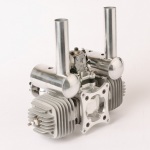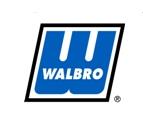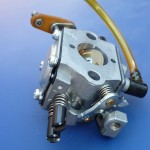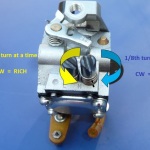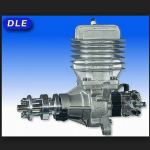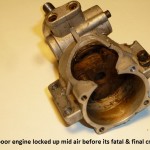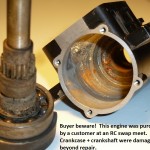DLA® MODEL ENGINE REVIEWS
Golden Skies R/C Aircraft, Inc., the U.S. distributor for the DLA product line, has sent us two of their most popular engines for a no-holds-barred product evaluation–the 58cc single and 116cc Twin Boxer.
We’ll start with some manufacturer and distributor facts and figures. Xi’an Feiao Model Co. has been manufacturing DLA model aircraft engines in China since 2004. Golden Skies R/C Aircraft has been importing and distributing these engines since 2010 and has a dealer network throughout the U.S., as well as four web dealers.
Let’s talk Parts and Warranty. PARTS: We have been assured by Golden Skies R/C that all current engine parts are fully stocked in their warehouse and their dealers are able to draw from Golden Skies R/C parts inventory and drop ship directly to the customer if necessary. WARRANTY: This speaks volumes–it’s three (3) years for the engines that we are testing (58cc single and 116cc Twin Boxer). The current lineup of DLA engines ranges from a 32cc single to a 128cc Quad Boxer. With that broad of a product range (and more on the horizon), this engine company has definitely become a mainstay in the R/C engine market.
Now a look at the engines in detail:
DLA 58cc SINGLE
– Carb and Intake Tract
The 58cc carb is a genuine Walbro WTA series that can be configured on the engine for either right-hand or left-hand throttle operation. One unique feature found on this carb is a plastic lever fitted to the choke shaft so that when the choke is closed the throttle is opened about 1/4 open, and when the throttle is advanced it releases the choke to the full open position. This set up worked great on the test bench. However, when installed in a plane, you will have to adjust the throttle trim up quite a bit to avoid fighting the throttle servo when the choke is closed. If you decide that you want independent control of the choke/throttle operation, just snip the plastic interlock lever with a pair of diagonal cutters. BUT be advised that there is no detent on the choke shaft when it is closed.
The reed cage is die cast aluminum and is machined on all critical surfaces. Note that the reed petals are attached using tiny sheet metal screws and CA glue (probably why Golden Skies provides only complete assemblies for replacement). The crankcase pulse routing is via a fitting in the carb spacer block.
– Crankcase
The 58cc crankcase is constructed from billet aluminum, fully machined inside and out. The main bearings are FAG (German origin) and are sealed 6002 and 6003 sizes.
– Crankshaft, Rod, Piston
The crank of the 58cc appears to be forged, with all critical surfaces either nicely machined or ground. It has a pressed-in, shouldered crank pin that holds the 12mm x 16mm needle roller bearing by IKO (Japan).
The connecting rod is a fully machined forging that has generous lubricating slots for the big end bearing. The top end bearing is a 10mm x 14mm needle roller by IKO (Japan). The width of the top of the rod dictates the rod-to-crank alignment. The piston is pressure die cast with a slightly domed crown.
Piston pin retention is via spring steel circlips. The single piston ring appears to be cast iron and has an end gap of 0.008” (8 thousandths of an inch).
– Cylinder and Exhaust
The cylinder of the 58cc engine is typical cast construction with a chrome-plated/honed bore. The piston-to-cylinder clearance measured at 0.003” with no bore taper measured. The transfer ports are as smooth as can be expected from this type of construction. The muffler is of lightweight aluminum construction parts that have been furnace brazed together and then polished. Here is an area for concern and, likely, premature gasket failure. When this muffler was made, I am sure that the mating surface was flat, but after the polisher got finished with it, a wavy surface was created, as well as rounded edges.* So, my advice is to true the mounting flange using a surface plate and 320 grit sandpaper before mounting the muffler to the engine.
– Hardware and Miscellaneous
All of the major fasteners on the 58cc engine are 5.0mm x 0.8mm socket head cap screws.
12.9 grade carbon steel is used for the cylinder mounting bolts, prop mounting bolts, and carb/intake mounting bolts.
A2-70 (304) stainless steel is used for the crankcase assembly bolts, muffler mounting bolts, and engine standoff mounting bolts (both engine and firewall sides).
The lock washers provided with the 58cc are good quality, but the provided flat washers are junk; throw them away and use some from RTL or similar high quality supplier.**
The prop hub is fully machined from aluminum bar stock and is attached to the crank by a Woodruff key and taper using a stainless steel prop hub nut that also matches a taper on the front side of the prop hub. The prop mounts with four bolts using the same pattern as DA and DLE engines.
– Electrical Components
The ignition module is a solid-state auto-advancing unit that will operate on a voltage supply of 6.6V to 8.4V and is both FCC and European tested and compliant for electromagnetic interference (the European standards for this type of component are stricter than the FCC). All electrical leads from the module are clearly marked for their connection and are generous in length. A tachometer output lead is also incorporated. The supplied spark plug is a CM-6 gapped at 0.018” and has iridium electrodes. The ignition timing was checked and found at 28° before top dead center (BTDC), which is the industry standard, not found on some of the competitors’ engines.
– Bench Test Run
Each DLA 58cc engine comes with a Factory Test Run Sheet, so we wanted to see how close our test results compared:
Their Prop: 22×10 Xoar
Our Prop: 22×10 Zinger
Their Fuel/Oil: 32:1 Premix unknown brands
Our Fuel/Oil: Chevron regular/Red Line Oil
Their RPM Figures: Idle = 1400, wide open throttle = 6450
Our RPM Figures: Idle = 1500, wide open throttle = 6800
Overall Evaluation Conclusion
The DLA 58cc is a well-constructed engine that uses superior materials and components over its rival Chinese competitors—and at an MSRP $70 less than its closest competition.
Hits Misses
3 Year Warranty. Muffler mounting surface not flat.*
Price point: MSRP $70 less than No choke butterfly detent when not
the nearest competitor’s MSRP. using the throttle interlock linkage
. for cold starting.
Comprehensive Owner’s Manual Poor quality flat washers provided.**
(47 pgs) available online
at goldenskiesrc.com.
Overall high quality of materials
and workmanship.
DLA 116cc TWIN BOXER
– Carb and Intake Tract
The 116cc carb is a genuine Walbro SDC series that is equipped with a choke-on throttle-up interlock lever that functions much the same as the 58cc engine. The throttle lever has a very nice push or pull extension that will work for almost any installation.
The reed cage is die cast aluminum and is fully machined on all critical surfaces. The reeds are mounted to the cage with 2mm machine screws.
– Crankcase
The 116cc crankcase is constructed from billet aluminum, fully machined inside and out. The surface finish inside the crankcase is ideal for smooth air/fuel delivery to the cylinders. The three main bearings are FAG (German origin) and are sealed 6003, 8203, 6001 sizes.
– Crankshaft, Rods, Pistons
The crank of the 116cc is a 5-piece, pressed-together assembly that shows high quality machined or ground surfaces. The big end bearings are IKO (Japan) needle roller, 12mm x 16mm.
The connecting rods appear to be the same as the one fitted to the 58cc single. Also, IKO (Japan) 10mm x 14mm needle roller bearings are fitted to the top end.
The pistons are the same as the one fitted to the 58cc engine. The ring end gaps measured at 0.008” (8 thousandths of an inch).
– Cylinders and Exhaust
The cylinders used on the 116cc are the same as the one fitted to the 58cc engine, and both measured at 0.003” piston-to-cylinder clearance, with no bore taper measured.
The exhaust mufflers are the same materials and construction as the one fitted to the 58cc but are specific to this engine.
– Hardware and Miscellaneous
All of the major fasteners on the 116cc engine are 5.0mm x 0.8mm socket head cap screws.
12.9 grade carbon steel is used for the cylinder mounting bolts, prop mounting bolts, and carb mounting bolts.
A2-70 (304) stainless steel is used for the reed block mounting, crankcase assembly bolts, muffler mounting bolts, and engine standoff mounting bolts.
The lock washers provided with the 116cc are good quality, but the provided flat washers are of the same poor quality as the ones fitted to the 58cc engine.**
The prop hub is fully machined from aluminum bar stock and is attached to the crank by a Woodruff key and taper using a stainless steel prop hub nut. The prop mounts with six bolts using the same pattern as DA and DLE engines.
– Electrical Components
The electrical/ignition components supplied with the 116 engine are of the same high quality manufacture and specifications as supplied with the 58cc engine. The base ignition timing was also found at 28° BTDC.
– Bench Test Run
Each DLA 116cc engine comes with a Factory Test Run Sheet; here’s how our test results compared:
Their Prop: 26×10 Xoar
Our Prop: 26×10 Menz
Their Fuel/Oil: 32:1 Premix unknown brands
Our Fuel/Oil: Chevron regular/Red Line Oil
Their RPM Figures: Idle = 1400, wide open throttle = 6200
Our RPM Figures: Idle = 1400, wide open throttle = 6600
Overall Evaluation Conclusion
The DLA 116cc is a well-constructed engine that uses superior materials and components over its rival Chinese competitors.
Hits Misses
3 Year Warranty. Muffler mounting surface not flat.*
Price point: MSRP $52 less than No choke butterfly detent when not
the nearest competitor’s MSRP. using the throttle interlock linkage
. for cold starting.
Comprehensive Owner’s Manual Poor quality flat washers provided.**
(47 pgs) available online
at goldenskiesrc.com.
Overall high quality of materials
and workmanship.
After writing this evaluation, it was brought to our attention that :
* The factory claims to have addressed the irregular muffler mounting surface.
** The factory claims to have since replaced the poor-quality flat washers with 304 stainless steel.
Having not seen these changes firsthand, we cannot evaluate for comment, but it would seem that the manufacturer is attentive to feedback and the need for improvements.




